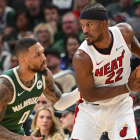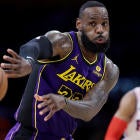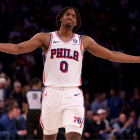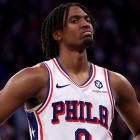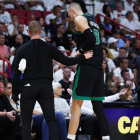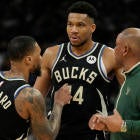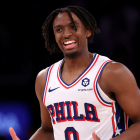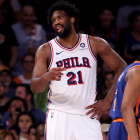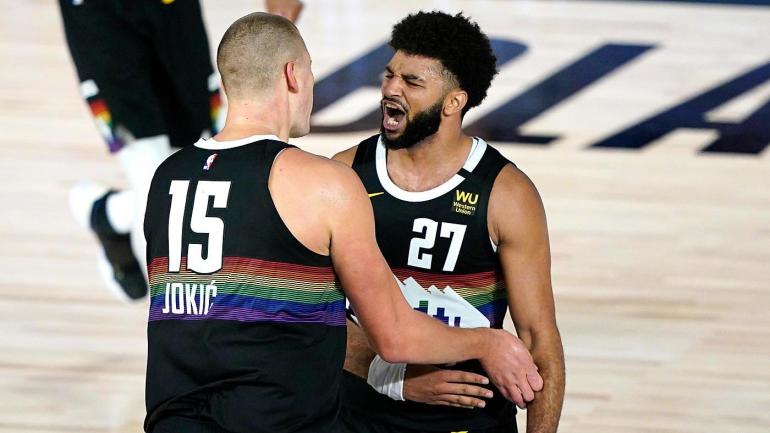
The Sacramento Kings had the most efficient offense in NBA history last season when they averaged 118.6 points per 100 possessions. De'Aaron Fox and Domantas Sabonis are All-Stars, but I think most readers would agree that they are far from the most talented offensive duo the league has ever seen. So how did Sacramento not only lap the 2023 field, but the entirety of league history last season?
Well, some factors were somewhat inevitable. Offense has grown significantly more efficient league wide over the past several seasons. Sacramento broke a record that had previously been set by the 2020-21 Brooklyn Nets at 117.3 points per 100 possessions, who themselves broke a record that had been set by the 2019-20 Dallas Mavericks at 115.9 points per 100 possessions. Someone was going to break Brooklyn's record, but why the Kings, specifically? The Kings stood out in five areas:
- The Kings ranked sixth in the NBA in 3-point attempts per game (37.3).
- The Kings ranked seventh in the NBA in fast-break points per game (14.9).
- The Kings ranked seventh in the NBA in free throw attempts per game (25.1).
- The Kings ranked fourth in the NBA in passes per game (299.3) and third in potential assists (49.7).
- The Kings were by far the healthiest team in the NBA last season. All five of their starters missed fewer than 10 games. They used the same starting lineup of Fox, Sabonis, Kevin Huerter, Keegan Murray and Harrison Barnes in 61 of their 82 games and that lineup played 900 total minutes. Only two other lineups even reached 600 last season.
So what is the message here? Notice that these numbers emphasize process over results. The Kings were a pretty good shooting team from both the line and from deep... but they were great at just getting those shots in the first place. They forced the issue in transition when they could for easy baskets and they moved the ball to create better looks. The Kings may not have been the best team in the league in any of those areas, but they were among the best in all of them and they almost always had all of their best players at their disposal. That, more than anything, led to their offensive success.
And it's the biggest measure we'll use to rank this season's 30 offenses before opening night. These rankings are not solely based on sheer talent. They will account for depth, durability, shot profiles and coaching track records. We are attempting to predict where all 30 teams will ultimately rank when the dust settles in April, not how they look on paper today. With that in mind, let's begin:
1. Denver Nuggets
What they'll do well: They have the best offensive player in the world (Nikola Jokic). That player has never played fewer than 69 games in a season (and only fell below 70 last year because of how quickly Denver clinched home-court advantage). They're bringing back all five starters, giving them a significant continuity advantage on almost every other elite offense. They were the only team in the NBA last season to finish in the top-five in 3-point percentage (fourth), points in the paint (fourth) and fast-break points (fifth). Rookie Julian Strawther is shooting a blistering 45.2% on nearly eight 3-point attempts per game in the preseason, giving this bench the sharpshooter it has largely lacked.
Where they'll struggle: Depth was an issue even with Bruce Brown and Jeff Green on the roster. Both are gone now. Brown was the de-facto backup point guard last season, and if Denver had much faith in Reggie Jackson to replace him, they likely would've given him real playoff minutes. The offense has declined by an average of 16.7 points per 100 possessions with Jokic on the bench over the past three seasons, and they haven't solved the backup center problem. Jamal Murray is in just his second season back from a torn ACL, while Michael Porter Jr. remains a significant injury risk.
2. Milwaukee Bucks
What they'll do well: The Damian Lillard-Giannis Antetokounmpo pick-and-roll is going to be unguardable. Build a wall for Antetokounmpo and Lillard will take a dozen pull-up 3's every night. Blitz Lillard and Antetokounmpo has a numbers advantage for the first time in his career. The decision to start Malik Beasley indicates that this team is prioritizing points above all else. The shooting depth is incredible as almost every member of the rotation is at least decent from deep. Most are a good deal better. Brook Lopez can still get you some post-up points, and Khris Middleton is overqualified as a third option.
Where they'll struggle: Everyone is old. Lillard is 33. Lopez is 35. Middleton is 32 and played only 33 games last season (and not especially well by his standards). Mike Budenholzer was one of the best regular-season offensive coaches in basketball. How much of his system will Adrian Griffin replicate? Is Cameron Payne a viable backup point guard when he isn't sharing minutes with Devin Booker or Chris Paul? Phoenix lineups featuring Payne and neither of his more famous backcourt-mates ranked in just the 20th percentile in offense last season, according to Cleaning the Glass.
3. Phoenix Suns
What they'll do well: Death by 1,000,000 mid-range jumpers. Last year's Nets (led partially by Kevin Durant!) hold the 21st century record for mid-range field goal percentage as a team at 48.9%, and the 2021 Suns (led by Devin Booker!) are in second place at 47.4%. Now Durant and Booker have a whole season together, and Bradley Beal is along for the ride. The bench has plenty of flaws, but between Grayson Allen, Eric Gordon and Damion Lee, there is plenty of shooting. Jusuf Nurkic is among the most annoying screeners in basketball for opposing defenders and injects sorely needed high-post playmaking. It's a tiny sample, but no team generated more fast break points per game in last year's playoffs than the Suns with Durant and Booker (18.3).
Where they'll struggle: The Suns ranked last in restricted area shots last season. Durant barely played for them, but his Nets ranked 26th and Beal's Wizards ranked 23rd. Is this team going to get to the rim consistently? A lot of minutes are going to be allocated to designated defenders like Josh Okogie and Keita Bates-Diop. How will that impact spacing for the stars? How often will the stars even be on the floor? Durant has played in 58% of his team's games over the past three seasons and Beal is at around 64%. Nurkic is at 49% over the last four seasons.
4. Boston Celtics
What they'll do well: No coach emphasizes 3-pointers to the degree that Joe Mazzulla does. Boston jumped from ninth to second in attempts per game last season. Jayson Tatum and Jaylen Brown had down shooting years, but the rest of their core six all shot at least 38% last season, and key reserves Sam Hauser and Payton Pritchard should be in that range as well. Assuming they stagger their best players properly, they'll always have at least two All-Star-caliber players on the floor.
Where they'll struggle: Boston never gets to the line. The Celtics ranked 28th in free throw attempts last season. They rarely get to the rim either, ranking 23rd in paint points a season ago. Their offseason changes will help on both fronts, but these are still relative weaknesses for the Celtics. When their shots go in, they'll be unbeatable. When they don't? Well, let's see what else this team has up its sleeve.
5. Sacramento Kings
What they'll do well: Everything they did well last year, which, as we covered above, is basically everything. There's no reason to believe Sacramento will suffer major injury issues this season. They remain pretty good at just about every element of offense. They've improved their shooting slightly by adding Chris Duarte and EuroLeague MVP Sasha Vezenkov. Their roster is still relatively young with room for internal growth. Fox's speed and Sabonis' incredible screening are still a lethal combination.
Where they'll struggle: They probably aren't going to be 10 points per 100 possessions better in clutch situation than the rest of the league this season because clutch performance tends to be somewhat random if your point guard isn't Chris Paul. Even if they don't suffer major injuries, they'll likely have a few more dings and bruises. They won't sneak up on anyone this year.
6. Dallas Mavericks
What they'll do well: Do you like dribbling? Then, boy, do I have the offense for you. Luka Doncic led the NBA in isolation field goal attempts per game (5.5) and Kyrie Irving ranked sixth (4.1). Fortunately, they're both quite good at individual shot-creation. as each topped 1.1 points per possession in isolation last season and nearly did so in pick-and-roll as well. Lineups featuring the pair of them rated in the 94th percentile in terms of offensive efficiency, according to Cleaning the Glass. Dallas ranked third in the NBA in 3-point attempts last season, and after adding Seth Curry and Grant Williams they may even be better from deep this year. They didn't sacrifice from the line to get all of those 3's either, as they ranked fifth in the NBA in free-throw attempts.
Where they'll struggle: Are they really going to start a rookie center in Dereck Lively? Jason Kidd yanked Christian Wood's minutes around last season because he didn't trust him on defense. Will he do that to anyone this season? Dončić has played 70 games only once in his career. Irving's durability concerns speak for themselves, so does the drama that tends to follow him everywhere he goes. Is there any shot-creation beyond the top two? That largely depends on Curry's health after ankle issues ruined his previous season and whether or not Kidd is willing to give Jaden Hardy room to grow on the floor.
7. Golden State Warriors
What they'll do well: The only team that attempted more 3's than Boston last season was Golden State, and only the 76ers made a higher percentage of their 3's than the Warriors. Bench offense has been a weakness throughout the Stephen Curry era, with the Warriors scoring an average of 13.6 fewer points per 100 possessions with him on the bench during his eight healthy seasons under Steve Kerr. Chris Paul is an ideal solution to this problem. He'll be able to run a competent regular season pick-and-roll as long his body remains upright. Preseason Jonathan Kuminga has been incredible. The wasted James Wiseman minutes are gone, the infuriating Jordan Poole turnovers are gone and Golden State leads the NBA in passes almost every year.
Where they'll struggle: They're older the Bucks and as injury-prone as the Suns. Draymond Green already has a sprained ankle. Their shot-selection issues are perhaps even more pressing than Phoenix's, as last season's roster, which is fairly similar to this season's, ranked last in free throw attempts and 28th in restricted area shot attempts. Someone out of Curry, Green, Paul, Klay Thompson, Andrew Wiggins and Kevon Looney is coming off of the bench. How will that affect team chemistry? Can Paul, who holds the ball longer than almost anyone in the NBA, conform to a style that relies on frequent movement and passing? Meanwhile, Thompson, Kuminga and Moses Moody are all playing for contracts.
8. Atlanta Hawks
What they'll do well: Trae Young's last three offenses have ranked seventh, second and ninth. Quin Snyder's last three full seasons of offense have ranked first, fourth and ninth, respectively. Pair arguably the NBA's best regular-season pick-and-roll operator with arguably the NBA's best regular-season pick-and-roll offense designer and you're going to get a pretty good offense. Dejounte Murray is a solid secondary creator in that context, but his mid-range game will be an even more valuable change of pace on a roster that will finally have the green light to fire all of the 3's Nate McMillan didn't let them take.
Where they'll struggle: Atlanta's shot-selection will likely improve significantly under Snyder, but this is still a team that relies heavily on Young's floater and Murray's overall mid-range game. The Hawks don't have Phoenix's talent or shooting depth. They're going to have to find ways to get to the rim and get to the line. Clint Capela spent the offseason in trade rumors. If he does eventually get dealt to make way for Onyeka Okongwu, the Hawks will badly miss his offensive rebounding. Bogdan Bogdanovic has averaged only a bit more than 50 games per season as a Hawk and is almost always banged up with something.
9. Indiana Pacers
What they'll do well: The Pacers were the NBA's best transition offense last season, and the addition of Obi Toppin should make them even better. The former Knick averaged over 20 points per game as a starter in New York, but only started 15 games in three years. No big man in the NBA runs the floor better than he does, and Tyrese Haliburton is going to give him several clean lobs per game. Indiana ranked seventh in the NBA in both 3-point and restricted area attempts last season, and Rick Carlisle teams always emphasize high-efficiency shots. Benedict Mathurin hit the rookie wall last season, but if he takes a step, his aggressive driving game meshes perfectly with Haliburton's finesse.
Where they'll struggle: There isn't a traditional late-clock shot-creator here, so when their gorgeous transition game is forced to slow down, they're going to encounter some problems. The Pacers ranked just 24th in half-court points per play last season, and even with some improvement, that likely isn't a strength. Buddy Hield is due an extension and was in trade rumors earlier this offseason when a deal wasn't struck. His shooting is very valuable here.
10. New York Knicks
What they'll do well: New York is, ironically, Indiana's opposite. The Knicks were one of the NBA's slowest teams last year, but made up for it by generating the second-most points per possession in the half-court. Jalen Brunson and Julius Randle are incredibly reliable regular-season shot-creators, and are annoying to game-plan against because of how rare their playing styles are. Brunson's craft distinguishes him from the speed and shooting range of most high-end pick-and-roll point guards, and Randle's strength and touch make him more versatile than most bigs. The Knicks replaced Toppin with Donte DiVincenzo, adding badly needed shooting and practically forcing Tom Thibodeau to play more small lineups. The Knicks run one of the NBA's tightest rotations, rarely allocating any minutes to players outside of the core rotation. That's not ideal for player-development, but great for maintaining consistent performance.
Where they'll struggle: The roster practically demands small-ball, at least out of bench units. Will Thibodeau oblige? He rarely has. The Knicks improved their shot-selection significantly last season, but were still somewhat mediocre when it came to scoring near the rim. That's the sort of spacing problem teams that start multiple big men face, and, quietly, Josh Hart doesn't get guarded much from deep either. There's not nearly enough ball-movement here, as New York ranked 22nd in passes per game. DiVincenzo will help a bit on this front, but too much of this offense simply boils down to two players in Randle and Brunson creating their own looks.
11. Philadelphia 76ers
What they'll do well: Throwing the ball to Joel Embiid at the high post is among the easiest ways to generate two points in all of basketball. More so, Tyrese Maxey is ready for a breakout. He averaged 24.8 points and 5.4 assists in games James Harden missed last season. No team made a higher percentage of its 3-pointers last season. Though the depth is flawed, no coach relies more on his starters than Nick Nurse.
Where they'll struggle: We have no idea what, if anything, to expect out of Harden. Losing the NBA's assists leader, either through a trade or indifference, would be a significant blow. Nurse's half-court offenses have largely been bad in Toronto, and while personnel played a big part, his schematic brilliance has largely come on defense. The starting lineup basically plays 4-on-5 offensively because of P.J. Tucker. Is that possible without a Harden-level shot-creator involved?
12. Minnesota Timberwolves
What they'll do well: The first season Gobert spent with Mike Conley saw the Jazz rank ninth on offense. The second and third saw jumps to fourth and first. Their chemistry is a massive improvement on D'Angelo Russell. Anthony Edwards was the breakout star for Team USA over the summer. Karl-Anthony Towns is probably going to play more than 29 games this season, and if Minnesota can convince him to spend more time spacing the floor in the starting units, it will make life significantly easier for Edwards, whom the team should be built around. Kyle Anderson and Naz Reid bring unique traits most teams would kill to have on their bench. Chris Finch is among the NBA's most creative offensive coaches.
Where they'll struggle: Towns-Gobert lineups were disastrous offensively last season. This ranking relies on improvement and, frankly, sacrifice that may not come. Conley is 36, so significant age-related decline is a major concern. Taurean Prince's shooting on the wing is a meaningful loss. This team has serious tax concerns, so if it starts out badly, there's some potential for a bad trade that saves money.
13. Los Angeles Lakers
What they'll do well: LeBron James and Anthony Davis are still a very strong starting point for an offense. The Lakers ranked fourth in the NBA in restricted area shot attempts largely because of them. The offseason improvements were largely based on juicing the offense. Gabe Vincent is a more reliable floor-spacer than Dennis Schroder was, and nobody guards Jarred Vanderbilt, so Taurean Prince minutes will alleviate some of the spacing concerns there. Christian Wood is the best scoring big man Davis has played with in Los Angeles, and James should enjoy a strong pick-and-roll partnership with him. Austin Reaves averaged just shy of 20 points per game in the last month of the regular season and was just as good in the playoffs. He's the best secondary ball-handler James has had in Los Angeles.
Where they'll struggle: James turns 39 this season. His raw stats don't show it yet, but he's starting to show the faintest signs of decline. His isolation and pick-and-roll numbers are down, replaced by spot-up attempts and transition freebies he's seeking out more aggressively than he once did. Both he and Davis have durability concerns. The shooting has improved but it's far from a strength. Is Rui Hachimura's playoff shooting sustainable? Probably not. The fact that he shot below 30% from 3 in the regular season as a Laker has largely been ignored.
14. Cleveland Cavaliers
What they'll do well: The Cavaliers will always have an All-Star level shot-creator on the floor between Darius Garland and Donovan Mitchell, and lineups featuring both of them ranked in the 89th percentile in offensive efficiency last season, according to Cleaning the Glass. They made a concerted effort to improve their shooting this offseason by acquiring Max Strus and Georges Niang. Those additions were needed to make their two-big lineups offensively viable. Speaking of those bigs, Evan Mobley took some small steps last season. He averaged just under 19 points per game in February and March before disappearing in the postseason. He'll need to keep improving, and third-year top-three picks generally do.
Where they'll struggle: Cleveland was the NBA's slowest team last season despite having a relatively athletic roster. Mobley has still taken less than 200 3-pointers in his career. Cleveland's two-big lineup surviving offensively revolves around the idea that Mobley will at least grow into a pseudo-threat from deep. That hasn't happened yet, and the Cavs haven't exactly reaped the benefits of their size either, as they are average offensively near the basket and below-average as an offensive rebounding team. We can't ignore the Mitchell rumors either. If this team doesn't start well, those are going to get louder.
15. Oklahoma City Thunder
What they'll do well: Shai Gilgeous-Alexander can beat anyone off the dribble and get to the rim. Only two players scored more points in the paint per game than he did last season: Zion Williamson and Giannis Antetokounmpo. As a result, no team took more shots in the restricted area than Oklahoma City. The Thunder were the NBA's third-fastest team last season, and its youth and collective basketball IQ made them a nightmare to defend in the open floor.
Where they'll struggle: This offense dies whenever Gilgeous-Alexander sits, ranking in the 20th percentile in offensive efficiency, according to Cleaning the Glass. Shooting is a weakness as well unless Chet Holmgren outperforms expectations, and the Thunder are not only conservative when it comes to minutes and injury-management, but have so many young players that they need to actively try to develop that they wind up devoting more minutes to bad players than most teams trying to win.
16. Memphis Grizzlies
What they'll do well: The Grizzlies have been among the best offensive rebounding teams in the NBA for years now. Any team with a healthy Steven Adams would be, and having a big man next to him in Jaren Jackson Jr. that spaces the floor is an ideal combination. They're a menace in transition when Ja Morant is on the floor, and that's part of why they led the NBA in points in the paint last season. Luke Kennard made roughly 900% of his 3-pointers once he arrived in Memphis. Like Maxey with Harden, Desmond Bane stepped up big time when Morant was out last season and is ready for a featured role early this season.
Where they'll struggle: Morant missing (at least) 25 games is pretty significant. Even when Morant is healthy, this has never been a particularly effective half-court offense, and Adams is recovering from an injury of his own. That puts a dent in their offensive rebounding. The Grizzlies are banking on Marcus Smart to replace both Dillon Brooks (as their best perimeter defender) and Tyus Jones (as their backup point guard). He should do just fine in the Brooks role, but he isn't nearly as steady offensively as Jones, and that will matter early in the season. Brandon Clarke, recovering from an Achilles tear, will be badly missed off the bench as well.
17. Los Angeles Clippers
What they'll do well: They're not quite as dominant as they once were, but the Clippers are still among the NBA's best shooting teams. They ranked third in 3-point percentage last season and eighth on mid-range shots. After years of struggling to get to the foul line, they rose up to 11th last season and figure to hover around league-average this season. Kawhi Leonard's mid-range jumper remains one of the most lethal late-game weapons in the league. Maybe James Harden will arrive at some point or maybe he won't.
Where they'll struggle: They never get to the basket. They hardly ever run, though the presence of Russell Westbrook helps a bit in that regard. Still, Westbrook throws a wrench in the shooting-heavy approach that has largely produced their best basketball since landing Leonard and Paul George. Despite his gaudy playoff stats, Clippers lineups featuring Westbrook and the stars only outscored opponents by 1.8 points per 100 possessions last season. It's a pretty uninspiring number, yet his reputation practically forces the Clippers to start him.
18. New Orleans Pelicans
What they'll do well: Williamson is the NBA's most dangerous interior scorer. Prior to his Dec. 19 injury, they ranked third in points in the paint with him around. Afterward, they fell to 14th. With him on the floor, they're almost impossible to guard near the rim. Perhaps not coincidentally, they fell from ninth to 17th in 3-point shooting after his injury because the gravity he generates was gone. This is relatively simple: Williamson warps the court in ways that make the Pelicans a good offense. Right now, he's playing. If he plays all year, the Pelicans have enough supplementary shot-creation with Brandon Ingram and C.J. McCollum to be a very good offense.
Where they'll struggle: Williamson never stays healthy for long. He's played 114 games in four years. When he goes down, this offense no longer makes sense. Shooting is a major issue with Trey Murphy already dealing with a torn meniscus. He was their only high-volume shooter as last year's team ranked 29th in 3-point attempts. Larry Nance Jr. is dealing with an ankle injury as well, and backup center becomes a problem if he can't play. McCollum's raw numbers look fairly strong, but he just averaged his fewest points on his lowest field goal percentage since 2016. Ingram's disastrous Team USA stint has more to do with what works on the FIBA stage, but it's not exactly an encouraging sign entering the season.
19. Charlotte Hornets
What they'll do well: When LaMelo Ball was healthy in 2022, the Hornets ranked second in the NBA in fast break points, third in points in the paint and sixth in 3-point attempts. Those three things alone will get an offense fairly far. Mark Williams should be the best lob-catcher Ball has ever played with. However you feel about the return of Miles Bridges, his presence should at least move Gordon Hayward to the bench, which would potentially keep him a bit healthier.
Where they'll struggle: Ball is incredible in transition and can shoot from Jupiter, but he hasn't grown nearly enough as a half-court shot-creator. Hayward's health is significant here, as he is the only reliable creator the Hornets have inside of the arc. We have no idea how Bridges will look after a year away from the team, and Brandon Miller will be given as many shots and minutes as he needs to grow regardless of his impact on winning.
20. Utah Jazz
What they'll do well: They largely take the right shots. Utah ranked fifth in the NBA in 3-point attempts and 29th in mid-range tries. Lauri Markkanen has always been able to shoot, but his growth as a ball-handler and athlete since arriving in the NBA is what has turned him into an All-Star. John Collins will likely help their uninspiring paint performance. Coach Will Hardy ran some of the NBA's best out-of-bounds plays last season.
Where they'll struggle: Did Collins shoot 29% from 3-point range last season because of an injured finger? Or should we expect sustained decline? Utah's offense relies on Collins making jumpers, especially given the uncertainty in the backcourt. Keyonte George has shined in the preseason, but rookie guards are almost never genuine positives as floor generals. Talen Horton-Tucker can't shoot and neither can Kris Dunn. Spacing isn't going to come as easily this season, especially if Kelly Olynyk is traded, and Mike Conley's veteran know-how went a long way towards pushing Utah into competitiveness last season.
21. Miami Heat
What they'll do well: Almost everyone on the roster shot below their typical percentages from deep last season, and a regression to the mean is part of what powered their run to the NBA Finals. They won't lead the NBA in 3-point percentage as they did during the 2021-22 season without Max Strus and Gabe Vincent, but they won't rank 27th as they did a year ago either. The Heat run one of the NBA's more egalitarian offenses, ranking seventh in the league in passes last season. Almost everybody in the rotation can actually handle the ball, and Bam Adebayo has quietly grown into one of the league's best passing centers.
Where they'll struggle: Without Strus and Vincent they're probably going to be closer to 27th in 3-point shooting than 1st. This team is pathologically averse to running, a trait that serves it well in the postseason and quite badly in the regular season. Jimmy Butler just turned 34 and hasn't played 70 games since 2017. There may be lingering bad blood after half of the roster spent the summer in trade rumors for Damian Lillard.
22. Brooklyn Nets
What they'll do well: Ben Simmons can create transition offense out of nothing. The 2021 76ers finished third in fast-break points with only Simmons and Maxey running. Brooklyn's defense is going to be so good and generate so many turnovers that transition opportunities will be plentiful. Mikal Bridges was an All-Star-caliber shot-maker once he arrived in Brooklyn, averaging over 26 points per game as a Net. That stellar Brooklyn defense gives the Nets leeway to play Cam Thomas real minutes. Thomas has no other above-average NBA skill, but he can put the ball through the rim.
Where they'll struggle: Relying on a healthy Simmons seems... unwise. Cam Johnson's durability issues aren't quite as bad, but he's far from reliable as well. There are a ton of shaky shooters here, and lineups with Simmons and Nic Claxton are going to feel very claustrophobic. Spencer Dinwiddie and Thomas make more sense on a team with a single, reliable shot-creator. On this roster, they're both going to need to generate far more than the Nets should be comfortable with.
23. Orlando Magic
What they'll do well: Generate mismatches. There is no single area in which the Magic excelled last season aside perhaps from getting to the foul line. What made their offense viable was how big and skilled everybody was. Paolo Banchero and Franz Wagner are too big for guards and too fast and crafty for most forwards. Wendell Carter Jr. was among the best shooters on the team at center. Mo Wagner can be, too, though he had a down year from deep. Markelle Fultz still can't shoot, but he can do basically everything else we hoped he would when he was drafted No. 1 overall in 2017.
Where they'll struggle: Joe Ingles and Gary Harris are the only reliable shooters on this roster and they're barely going to play. The backcourt is a mess with five recent first-round picks (Fultz, Jalen Suggs, Cole Anthony, Anthony Black and Jett Howard) all fighting for a long-term role. They're not nearly as good in transition as a team this young needs to be to survive on offense.
24. Houston Rockets
What they'll do well: There's going to be a baseline of competence, finally, after replacing the NBA's worst lead ball-handler (Kevin Porter Jr.) and head coach (Stephen Silas) with proven professionals in Fred VanVleet and Ime Udoka. The days of no organization are gone. Udoka is perfectly willing to bench players for freelancing. It remains to be seen how much of the offense will run through Alperen Sengun, but he has the potential to become the best shot-creating big man in the NBA not named Jokić. Jalen Green's nuclear athleticism means a lot more on a roster with some veterans who can help him take advantage of it.
Where they'll struggle: Where is the shooting coming from on this roster aside from VanVleet? The only returning Rocket to shoot above 34% on 3's last season was Tari Eason on roughly two attempts per game. Green has to improve from deep if this offense is going to be viable. The same is true of Jabari Smith Jr., though his improvement over the course of last season was encouraging. Dillon Brooks is going to shoot them out of games like he did the Grizzlies. Amen Thompson developmental minutes will pay dividends down the line but should be rough this season.
25. Chicago Bulls
What they'll do well: Make mid-range shots. Chicago attempted 2.1 more of them per game last season than any other team and ranked fifth in the NBA by making 44.5% of them. The Alex Caruso-Jevon Carter guard tandem is going to generate a bunch of turnovers that will hopefully breathe some life into a transition offense that was otherwise uninspiring without Lonzo Ball.
Where they'll struggle: Everywhere else. They took the fewest 3-pointers in the NBA by far last season. Additionally, they have major concerns with both age and health at several positions. They also don't get to the rim very often. If they're smart they'll blow this roster up in February, and, if they do, the last two horrible months of the season will only push them further down the list.
26. Washington Wizards
What they'll do well: Jordan Poole can take all of the shots his heart desires. Tyus Jones is a professional point guard auditioning for his next contract from a contender. Kyle Kuzma is great in space. They're not gonna really start tanking until the trade deadline.
Where they'll struggle: This clip from Thursday's preseason game against the Knicks should paint a pretty clear picture of what this season is going to look like for everyone not named Jordan Poole.
If you’re writing a preview for the 2023-24 Wizards just post this clip. pic.twitter.com/CMLXAWvCik
— Sam Quinn (@SamQuinnCBS) October 19, 2023
27. Portland Trail Blazers
What they'll do well: Anfernee Simons and Jerami Grant are above-average individual shot-creators for their position, and Scoot Henderson is going to be one of the most athletic guards in the NBA from the moment he debuts. There is a surprising amount of competence spread throughout this roster. Malcolm Brogdon just won Sixth Man of the Year and Deandre Ayton can finally post up from time to time. There are too many good players on this roster for Portland to finish dead last.
Where they'll struggle: Rookie point guards put up fun stats and usually lead very bad offenses. There's also a reason Phoenix didn't want to give Ayton the ball as much as he wanted. Brogdon will be gone by February, and if someone is willing to take on his contract, Grant will be too.
28. Toronto Raptors
What they'll do well: Run. Toronto's defense tends to generate a ton of turnovers, and the Raptors are so athletic that they make good use of those transition opportunities to generate free buckets. They ranked third in offensive rebounding last season, and Jakob Poeltl's presence on the roster all season should only help on that front.
Where they'll struggle: Half-court offense. All of it, the whole thing. The Raptors ranked 25th in half-court points per play and just swapped out their best shooter, VanVleet, for a below-average one in Schröder. OG Anunoby is the best shooter in this starting lineup at 37.5% from deep for his career. If Schröder starts over Gary Trent Jr., nobody else in the starting lineup will be at even 34%.
29. San Antonio Spurs
What they'll do well: If Jeremy Sochan does wind up starting at point guard, all five San Antonio starters will be at least 6-foot-5. That's going to create some fun potential for mismatches, and this roster is athletic enough to do well in transition. Victor Wembanyama will lead the league in highlights.
Where they'll struggle: Jeremy Sochan is a 6-8 forward that averaged 9.2 points and 1.8 assists per game in his lone college season and had the seventh-highest usage rate on his own team last season. The idea of starting him at point guard is to develop his promising ball-handling and playmaking skills. In the short term, it would be disastrous. That's the tagline for this entire Spurs season. They didn't add any meaningful veterans despite having max cap space over the summer. This is a "let's see what we have" season in San Antonio. They don't care about winning yet.
30. Detroit Pistons
What they'll do well: Cade Cunningham excelled as a member of Team USA's Select Team over the summer. As a former No. 1 overall pick in his third season, it wouldn't be crazy to see him contend for an All-Star slot under normal circumstances.
Where they'll struggle: These are not normal circumstances. Why are there so many centers here? Jaden Ivey, Ausar Thompson and Killian Hayes are all poor shooters at this stage of their careers. The Pistons are going to have to balance their need to develop them with the shooters they actually have on the roster in Joe Harris, Bojan Bogdanovic and Alec Burks. It's hard to trust a team to adequately do so when that team just can't stop adding centers. Monty Williams teams tend to have terrible shot-selection, as Phoenix has illustrated with its mid-range fixation. This roster needs significant changes before it can score acceptably.














